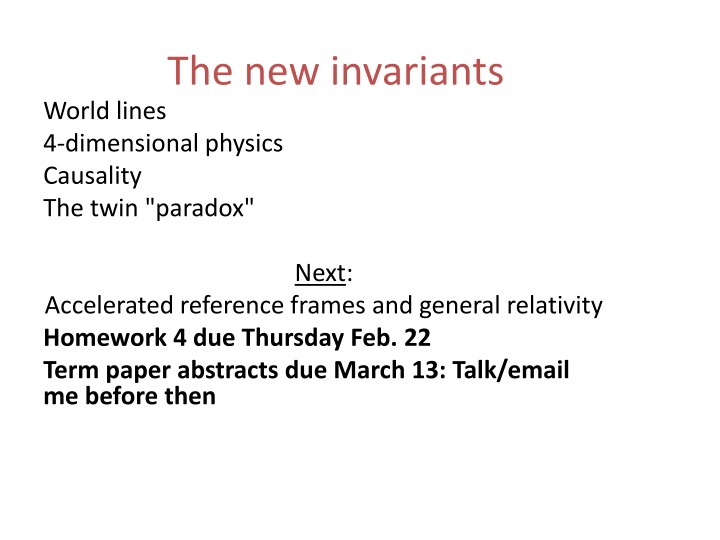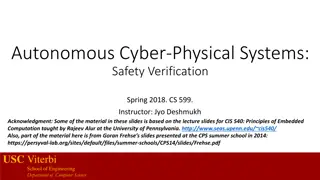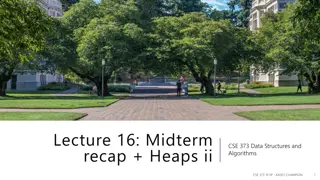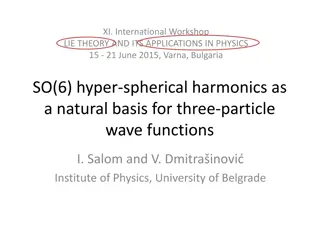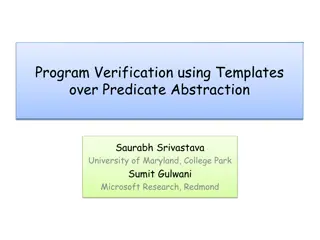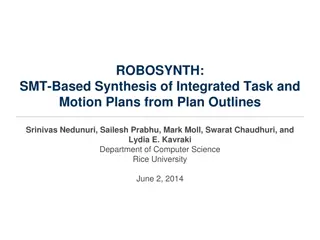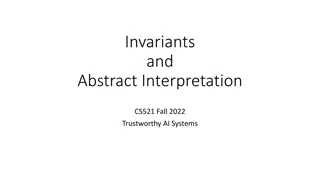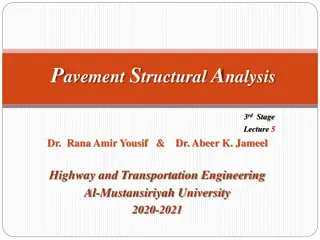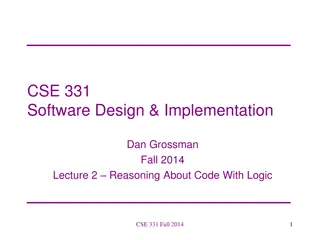The new invariants
Delve into the fascinating realm of 4-dimensional physics as we unravel the intricacies of causality, address the twin paradox, and uncover the dynamics of accelerated reference frames in general relativity. Discover the invariants that shape our understanding of the universe and explore the implications of these concepts in the realm of theoretical physics. Dive deep into the world of advanced physics and expand your knowledge in this thought-provoking field.
Download Presentation

Please find below an Image/Link to download the presentation.
The content on the website is provided AS IS for your information and personal use only. It may not be sold, licensed, or shared on other websites without obtaining consent from the author.If you encounter any issues during the download, it is possible that the publisher has removed the file from their server.
You are allowed to download the files provided on this website for personal or commercial use, subject to the condition that they are used lawfully. All files are the property of their respective owners.
The content on the website is provided AS IS for your information and personal use only. It may not be sold, licensed, or shared on other websites without obtaining consent from the author.
E N D
Presentation Transcript
The new invariants World lines 4-dimensional physics Causality The twin "paradox" Next: Accelerated reference frames and general relativity Homework 4 due Thursday Feb. 22 Term paper abstracts due March 13: Talk/email me before then
4-dimensional spacetime Three-dimensional geometry becomes a chapter in four-dimensional physics. ... Space and time are to fade away into the shadows. (Minkowski, 1908) The geometrical interpretation of SR is based on the similarity between rotations and Lorentz transformations. Take two coordinate systems, rotated with respect to each other: Coordinate rotation doesn t change the distance between points P and Q: x 2+ y 2 = x2 + y2. sin2 + cos2 = 1 expresses this invariance of distance under rotations. The two people get different x and y, but agree about d. y y' = = + + cos sin x sin cos y x y x y P x' Q x x =g (x -bt) = t =g (t -bx) = -gbx + g t g x-gbt The Lorentz transformation looks ~like a rotation: (I m ignoring y and z.) You can verify that (t )2 - x 2 = (t)2 - x2. Although two observers measure different lengths and time intervals, they agree on the value of this quantity, the interval . (Note the minus sign, it's defined to be more like a time interval than a space interval.)
Relativity is full of invariants they just aren't the ones you expected. Minkowski interpreted the invariant interval as a geometrical quantity in a non- Euclidean geometry. It has quantities similar to the trigonometric functions, called hyperbolic trigonometric functions (e.g., hyperbolic sine, etc.). Using this mathematics, we can interpret the Lorentz transformation as a non- Euclidean rotation : x = xcoshq -tsinhq t = -xsinhq +tcoshq Except for the - sign, this is like a rotation. That - sign is the indicator the time dimension is not like the 3 space dimensions. The universal speed, c, now has a geometrical meaning: the conversion factor between space and time units. Suppose we measured x in meters and y in feet: y y' P With these units, the quantity x2 + y2 is not invariant under rotations. In fact, until we make the units agree, we can t even combine them. We must multiply y by a conversion factor, k, which is the number of meters per foot. Then x2 + (ky)2 is invariant. x' Q x
4-dimensional physics The principle of relativity requires that if the laws of physics are to be the same in every inertial reference frame, the quantities on both sides of an = sign must undergo the same Lorentz transformation so they stay equal. You cannot make any invariant from space or time variables alone. That's why we call the SR world 4-D, and call the old world 3-D + time. No true feature of the world itself is representable in the 3 spatial dimensions or the 1 time dimension separately. In Newtonian physics, p=mv(bold means vector). Momentum and velocity are vectors, and mass is a scalar (invariant) under 3-d rotations. This equation is valid even when we rotate our coordinates, because both sides of the equation are vectors. The new momentum is a 4-d vector (4-vector for short). It s fourth component is E/c, the energy. The factor of c is needed to give it the same units as momentum. The lengths of 3-vectors remain unchanged under rotations. So does the invariant length of 4-vectors under Lorentz transformations. The length2 of a 4-vector is the square of its "time" component minus the square of its space component: (E/c)2 - p2 = (m0c2)2
4-D geometry In the geometrical interpretation of SR, c is just a conversion factor, the number of meters per second. The geometrical interpretation of SR helped lead Einstein to general relativity, although it didn t directly change the physics. World lines A graph of an object s position versus time: If an object is at rest in any inertial reference frame, its speed is less than c in every ct ct world line Our view: His view: world line light line light line (ct)2- x2 =(ct )2- x 2 reference frame. The speed limit divides the spacetime diagram into causally distinct regions. B B A A x x Lorentz_transform_of_world_line.gif ct A, B, C, & D are events. A might be a cause of B, since effects produced by A can propagate to B. They cannot get to D without travelling faster than light, nor to C because it occurs before A. C might be a cause of A, B, and/or D. D could be a cause of B, since light can get from D to B. If the interval, (ct)2 - x2, between pairs of events is positive ( timelike ), then a causal connection is possible. If it is negative ( spacelike ), then not. A's f ut ure B A's elsewhere D A x C A's past
Space-time diagrams Future (here) time space (present) Past (here)
Space-time diagrams Future (here) time Light cone Can reach timelike Spacelike inaccessible space (present) Can detect Past (here)
Spacetime from rocket Future (here) time Light cone Can reach timelike Spacelike space (present) inaccessible Can detect Past (here)
Space-time diagrams Particle world line Future (here) time Light cone Can reach timelike Spacelike inaccessible space (present) Can detect Past (here)
Causality in Special relativity Strong form: No event can be affected in any way by events outside its past light cone. Weak form: No information may be transmitted except forward within a light cone. Weaker form: No information can be transmitted except within a light cone. You may wonder why we make such pointless distinctions. Can't any "effect" be used to transmit information? Stay tuned. In a deterministic world, the Strong form would mean that an event would be completely predictable on the basis of knowledge of its past cone alone. Observations OUTSIDE the past light cone might provide the same info in more convenient form, but would never be needed, because everything knowable about the event would be determined by the preceding events in the light cone. What about in a world where things are not completely predictable on the basis of anything? The Strong form would mean that one could find within the past light cone enough information to obtain as much predictive accuracy as possible about an event.
What does Nothing can travel faster than the speed of light mean? We know that no ordinary mass can go faster, because that would require infinite energy. no conserved quantity can go faster, because then it would not be conserved in some reference frames. If we believe that causation must go forward in time, then we know that no "information" can go faster than c, because that would allow backwards-in-time causation. What happens if you can send info backward? Say you send your grandma info that somebody much cuter than your grandpa was about to move into her neighborhood. Then you aren't born. Then the info doesn't get sent. So you are born, so .
What does "no object travels faster than c mean? If "no object travels faster than c", then the following aren't objects: The bright spot made by a beacon shining on a wall. The cutting point of a scissors. The crest of an E-M wave in matter. (Certain materials have index of refraction less than 1 over some frequency range, hence a "phase velocity" greater than c for some light.) The repetitive pattern carries no info! Only the breaks in the repeating pattern must travel slower than c. What are we then claiming? If we are to describe the world as having some primary constituents, with various higher-level phenomena just being patterns in the constituents' behavior, we want to restrict the primary constituents to those which don't travel faster than light. We claim there exists some complete description of the world in terms of constituents which don't travel faster than c.
Causality in Special relativity Things: One version of positivism tried to reduce all statements to simple relations among "things". You are all familiar with statements such as "No two things can be in the same place at the same time." We see statements like "No thing can travel faster than the speed of light." So what is a thing ? Is the Mississippi river a thing? (What would Heraclitus have said?) Is a person a thing? Is a moving bright spot on the wall a thing? If you believe in external reality, is it necessary to believe it consists of well-defined things? If not, what becomes of statements like those above? Do things exist outside our description of events?
What has SR changed philosophically? The old invariants (t, lengths, m ) (things which were "real" in that they were observer-independent) have been tossed out. They are replaced with new invariants (c, d2-c2t2, E2-c2p2 ) which have a slightly more complicated relation to our customary observations. If we had evolved experiencing many relative speeds close to c, there would be absolutely nothing philosophically exotic or particularly "relativistic" about "relativity". The Lorentz transformations would make sense to us in the same way that the Galilean transformations make sense. We would just have a different set of invariants. That's why Einstein wanted to name the theory "Invariants theory. The philosophical excitement comes from the transformation from one theory to the other- ideas that seemed immutable turned out to be mutable, and there's a lesson to be learned from that process.
The twin paradox Suppose Alice and Beth are twins. Alice sets off in her rocket so fast that the time dilation factor becomes 1.2. She travels away from Earth for 5 years, as measured by Beth, who has remained on Earth. Alice then turns around and returns to Earth at the same rapid pace. Alice Beth Alice Alice When Alice returns home, Beth has aged 10 years. How much has Alice aged? There appears to be a paradox. According to the Lorentz transformation, during the time Alice is travelling: Beth says: I measure Alice s clock to be running slow, so she has aged only 8 years. Alice says: My clock is fine. I measure Beth s clock to be running slow, so she has aged only 8 years. They start and end standing right next to each other, so a direct comparison of clocks is possible. Who is correct?
Spacetime diagram attribution?
Resolution The answer is that Alice, the twin who turned around, has aged less. The situation is not symmetrical, because in order to return to Earth, Alice must have accelerated. Our descriptions of how things looked to different observers (Lorentz transformations) so far do not describe accelerated observers, so we only know how things look to Beth. Of course Alice must agree that Beth is older, when they now stand side-by side. Now we can put together a conclusion about how Beth must have looked to Alice while Alice was accelerating. While turning back (accelerating toward earth), Alice must observe Beth's clock to be running fast, not slow. So this is not a paradox at all but just a reminder that the SR transformations only work between reference frames which are not accelerating (at least with respect to each other, leaving aside the question of absolute acceleration.) But you can also see that from SR we can draw conclusions about how things must look to accelerating observers. Let's go further in seeing how things look to accelerating observers. In particular, let's look for ways in which the simple laws of physics might get messed up in their frames.
Historical Reactions to Special Relativity The Universe begins to look more like a great thought than like a great machine. Mind no longer appears as an accidental intruder into the realm of matter. J. H. Jeans (1930) Even space and time are forms of intuition which can no more be divorced from consciousness than our concepts of color, shape and size. Space has no objective reality except as an order or arrangement of the objects we perceive in it.. Lincoln Barnett (1948) The special theory of relativity takes refuge in a purely mathematical description.. It refrains from putting the question for the objectivity of physical phenomena. Soviet Encyclopedia (1937) Actually Newton s metaphysical doctrine on space and time has lived behind the stage. The historic merit of Einstein consists in his criticism of the ancient metaphysical ideas on space and time. S. I. Vavilov (1938) The formulation that the phenomena of nature obey a Principle of Relativity is nothing but the expression of a radically materialistic attitude. Nazi indoctrination talk (1938).
There has been a tendency, not uncommon in the case of a new scientific theory, for every philosopher to interpret the work of Einstein in accordance with his own metaphysical system, and to suggest that the outcome is a great accession of strength to the view which the philosopher in question previously held. Bertrand Russell (1925)
